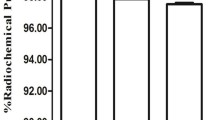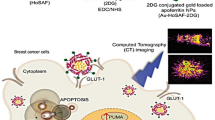Abstract
Purpose
Targeted delivery in vivo remains an immense roadblock for the translation of nanomaterials into the clinic. The greatest obstacle is the mononuclear phagocyte system (MPS), which sequesters foreign substances from general circulation and causes accumulation in organs such as the liver and spleen. The purpose of this study was to determine whether attaching an active targeting antibody, 5B1, to the surface of gold nanoparticles and using clodronate liposomes to deplete liver and splenic macrophages could help to minimize uptake by MPS organs, increase targeted delivery to CA19.9-positive pancreatic tumors, and enhance pancreatic tumor delineation.
Procedures
To produce the antibody-gold nanoparticle conjugate (Ab-AuNP), the Ab was conjugated to p-isothiocyanatobenzyl-desferrioxamine (p-SCN-DFO) and subsequently conjugated to NHS-activated gold nanoparticles. The Ab-AuNP was characterized by transmission electron microscopy (TEM) and atomic force microscopy (AFM). Modified Lindmo assay was performed to assess binding affinity and internalization potential in vitro. The Ab-AuNP was radiolabeled with 89Zr and injected into CA19.9-positive BxPc-3 pancreatic orthotopic tumor-bearing mice pretreated with or without clodronate liposomes for PET imaging and biodistribution studies. Inductively coupled plasma-optical emission spectrometry (ICP-OES) analysis was used to confirm delivery of gold nanoparticles to BxPc-3 pancreatic subcutaneous xenografts.
Results
Mice pretreated with clodronate liposomes in an orthotopic setting demonstrated decreased liver uptake at early time points (12.2 ± 2.3 % ID/g vs. 22.8 ± 3.8 % ID/g at 24 h) and increased tumor uptake at 120 h (13.8 ± 8.0 % ID/g vs. 6.0 ± 1.2 % ID/g). This allowed for delineation of orthotopic pancreatic xenografts in significantly more mice treated with clodronate (6/6) than in mice not treated with clodronate (2/6) or mice injected with gold nanoparticles labeled with a nonspecific antibody (0/5).
Conclusions
The combination of clodronate liposomes and an active targeting antibody on the surface of gold nanoparticles allowed for PET/CT imaging of subcutaneous and orthotopic pancreatic xenografts in mice.






Similar content being viewed by others
References
Cai W, Gao T, Hong H, Sun J (2008) Applications of gold nanoparticles in cancer nanotechnology. Nanotechnol Sci Appl 1:17–32
Pelaz B, Alexiou C, Alvarez-Puebla RA, Alves F, Andrews AM, Ashraf S, Balogh LP, Ballerini L, Bestetti A, Brendel C, Bosi S, Carril M, Chan WCW, Chen C, Chen X, Chen X, Cheng Z, Cui D, du J, Dullin C, Escudero A, Feliu N, Gao M, George M, Gogotsi Y, Grünweller A, Gu Z, Halas NJ, Hampp N, Hartmann RK, Hersam MC, Hunziker P, Jian J, Jiang X, Jungebluth P, Kadhiresan P, Kataoka K, Khademhosseini A, Kopeček J, Kotov NA, Krug HF, Lee DS, Lehr CM, Leong KW, Liang XJ, Ling Lim M, Liz-Marzán LM, Ma X, Macchiarini P, Meng H, Möhwald H, Mulvaney P, Nel AE, Nie S, Nordlander P, Okano T, Oliveira J, Park TH, Penner RM, Prato M, Puntes V, Rotello VM, Samarakoon A, Schaak RE, Shen Y, Sjöqvist S, Skirtach AG, Soliman MG, Stevens MM, Sung HW, Tang BZ, Tietze R, Udugama BN, VanEpps JS, Weil T, Weiss PS, Willner I, Wu Y, Yang L, Yue Z, Zhang Q, Zhang Q, Zhang XE, Zhao Y, Zhou X, Parak WJ (2017) Diverse applications of nanomedicine. ACS Nano 11(3):2313–2381
Nebuloni L, Kuhn GA, Muller R (2013) A comparative analysis of water-soluble and blood-pool contrast agents for in vivo vascular imaging with micro-CT. Acad Radiol 20(10):1247–1255
Popovtzer R, Agrawal A, Kotov NA, Popovtzer A, Balter J, Carey TE, Kopelman R (2008) Targeted gold nanoparticles enable molecular CT imaging of cancer. Nano Lett 8(12):4593–4596
Zhou B, Xiong Z, Wang P, Peng C, Shen M, Shi X (2018) Acetylated polyethylenimine-entrapped gold nanoparticles enable negative computed tomography imaging of orthotopic hepatic carcinoma. Langmuir 34(29):8701–8707
Farooq MU, Novosad V, Rozhkova EA, Wali H, Ali A, Fateh AA, Neogi PB, Neogi A, Wang Z (2018) Gold nanoparticles-enabled efficient dual delivery of anticancer therapeutics to HeLa cells. Sci Rep 8(1):2907
Paciotti GF, Zhao J, Cao S, Brodie PJ, Tamarkin L, Huhta M, Myer LD, Friedman J, Kingston DGI (2016) Synthesis and evaluation of paclitaxel-loaded gold nanoparticles for tumor-targeted drug delivery. Bioconjug Chem 27(11):2646–2657
Ghosh P, Han G, De M, Kim CK, Rotello VM (2008) Gold nanoparticles in delivery applications. Adv Drug Deliv Rev 60(11):1307–1315
Popovtzer A, Mizrachi A, Motiei M, Bragilovski D, Lubimov L, Levi M, Hilly O, Ben-Aharon I, Popovtzer R (2016) Actively targeted gold nanoparticles as novel radiosensitizer agents: an in vivo head and neck cancer model. Nanoscale 8(5):2678–2685
Rosa S, Connolly C, Schettino G, Butterworth KT, Prise KM (2017) Biological mechanisms of gold nanoparticle radiosensitization. Cancer Nanotechnol 8(1):2
Cui L, Her S, Borst GR, Bristow RG, Jaffray DA, Allen C (2017) Radiosensitization by gold nanoparticles: will they ever make it to the clinic? Radiother Oncol 124(3):344–356
Gustafson HH, Holt-Casper D, Grainger DW, Ghandehari H (2015) Nanoparticle uptake: the phagocyte problem. Nano Today 10(4):487–510
Wilhelm S, Tavares AJ, Dai Q, Ohta S, Audet J, Dvorak HF, Chan WCW (2016) Analysis of nanoparticle delivery to tumours. Nat Rev Mater 1(5)
Zhang YN, Poon W, Tavares AJ, McGilvray ID, Chan WCW (2016) Nanoparticle-liver interactions: cellular uptake and hepatobiliary elimination. J Control Release 240:332–348
Tsoi KM, MacParland SA, Ma XZ et al (2016) Mechanism of hard-nanomaterial clearance by the liver. Nat Mater 15(11):1212–1221
Byrne JD, Betancourt T, Brannon-Peppas L (2008) Active targeting schemes for nanoparticle systems in cancer therapeutics. Adv Drug Deliv Rev 60(15):1615–1626
Choi CH, Alabi CA, Webster P, Davis ME (2010) Mechanism of active targeting in solid tumors with transferrin-containing gold nanoparticles. Proc Natl Acad Sci U S A 107(3):1235–1240
Sawada R, Sun SM, Wu X, Hong F, Ragupathi G, Livingston PO, Scholz WW (2011) Human monoclonal antibodies to sialyl-Lewis (CA19.9) with potent CDC, ADCC, and antitumor activity. Clin Cancer Res 17(5):1024–1032
Houghton JL, Zeglis BM, Abdel-Atti D, Aggeler R, Sawada R, Agnew BJ, Scholz WW, Lewis JS (2015) Site-specifically labeled CA19.9-targeted immunoconjugates for the PET, NIRF, and multimodal PET/NIRF imaging of pancreatic cancer. Proc Natl Acad Sci U S A 112(52):15850–15855
Houghton JL, Abdel-Atti D, Scholz WW, Lewis JS (2017) Preloading with unlabeled CA19.9 targeted human monoclonal antibody leads to improved PET imaging with (89)Zr-5B1. Mol Pharm 14(3):908–915
Escorcia FE, Steckler JM, Abdel-Atti D, Price EW, Carlin SD, Scholz WW, Lewis JS, Houghton JL (2018) Tumor-specific Zr-89 Immuno-PET imaging in a human bladder Cancer model. Mol Imaging Biol 20(5):808–815
Perez-Medina C, Binderup T, Lobatto ME et al (2016) In vivo PET imaging of HDL in multiple atherosclerosis models. JACC Cardiovasc Imaging 9(8):950–961
Welch MJ, Hawker CJ, Wooley KL (2009) The advantages of nanoparticles for PET. J Nucl Med 50(11):1743–1746
Blanco E, Shen H, Ferrari M (2015) Principles of nanoparticle design for overcoming biological barriers to drug delivery. Nat Biotechnol 33(9):941–951
Storm G, Belliot SO, Daemen T, Lasic DD (1995) Surface modification of nanoparticles to oppose uptake by the mononuclear phagocyte system. Adv Drug Deliv Rev 17(1):31–48
Jokerst JV, Lobovkina T, Zare RN, Gambhir SS (2011) Nanoparticle PEGylation for imaging and therapy. Nanomedicine 6(4):715–728
van Rooijen N, Hendrikx E (2010) Liposomes for specific depletion of macrophages from organs and tissues. Methods Mol Biol 605:189–203
Kelly C, Jefferies C, Cryan SA (2011) Targeted liposomal drug delivery to monocytes and macrophages. J Drug Deliv 2011:727241
Dai Q, Wilhelm S, Ding D, Syed AM, Sindhwani S, Zhang Y, Chen YY, MacMillan P, Chan WCW (2018) Quantifying the ligand-coated nanoparticle delivery to cancer cells in solid tumors. ACS Nano 12(8):8423–8435
Tavares AJ, Poon W, Zhang YN, Dai Q, Besla R, Ding D, Ouyang B, Li A, Chen J, Zheng G, Robbins C, Chan WCW (2017) Effect of removing Kupffer cells on nanoparticle tumor delivery. Proc Natl Acad Sci U S A 114(51):E10871–E10880
Lindmo T, Boven E, Cuttitta F, Fedorko J, Bunn PA (1984) Determination of the immunoreactive fraction of radiolabeled monoclonal-antibodies by linear extrapolation to binding at infinite antigen excess. J Immunol Methods 72(1):77–89
Biewenga J, van der Ende MB, Krist LF et al (1995) Macrophage depletion in the rat after intraperitoneal administration of liposome-encapsulated clodronate: depletion kinetics and accelerated repopulation of peritoneal and omental macrophages by administration of Freund's adjuvant. Cell Tissue Res 280(1):189–196
Ohara Y, Oda T, Yamada K, Hashimoto S, Akashi Y, Miyamoto R, Kobayashi A, Fukunaga K, Sasaki R, Ohkohchi N (2012) Effective delivery of chemotherapeutic nanoparticles by depleting host Kupffer cells. Int J Cancer 131(10):2402–2410
Kunjachan S, Pola R, Gremse F, Theek B, Ehling J, Moeckel D, Hermanns-Sachweh B, Pechar M, Ulbrich K, Hennink WE, Storm G, Lederle W, Kiessling F, Lammers T (2014) Passive versus active tumor targeting using RGD- and NGR-modified polymeric nanomedicines. Nano Lett 14(2):972–981
Acknowledgments
The authors gratefully acknowledge the Radiochemistry and Molecular Imaging Probes Core Facility, the Small Animal Imaging Facility, and the Molecular Cytology Core Facility. The authors also gratefully acknowledge the Electron Microscopy Resource Center at The Rockefeller University. We gratefully acknowledge the Thompson Family Foundation, Inc., the Mr. William H. and Mrs. Alice Goodwin and the Commonwealth Foundation for Cancer Research, and the Center for Experimental Therapeutics of Memorial Sloan Kettering Cancer Center.
Funding
The Radiochemistry and Molecular Imaging Probes Core Facility, the Small Animal Imaging Facility, and the Molecular Cytology Core Facility were supported in part by NIH grant P30 CA08748. This study was also supported in part by NIH NCI R35 CA232130 (JSL).
Author information
Authors and Affiliations
Corresponding author
Ethics declarations
Conflict of Interest
JSL received 5B1 antibody and research support for these studies from MabVax Therapeutics. All other authors have no other disclosures in relationship to this manuscript.
Additional information
Publisher’s Note
Springer Nature remains neutral with regard to jurisdictional claims in published maps and institutional affiliations.
Electronic Supplementary Material
ESM 1
(DOCX 15.3 mb)
Rights and permissions
About this article
Cite this article
Sobol, N.B., Korsen, J.A., Younes, A. et al. ImmunoPET Imaging of Pancreatic Tumors with 89Zr-Labeled Gold Nanoparticle–Antibody Conjugates. Mol Imaging Biol 23, 84–94 (2021). https://doi.org/10.1007/s11307-020-01535-3
Received:
Revised:
Accepted:
Published:
Issue Date:
DOI: https://doi.org/10.1007/s11307-020-01535-3




